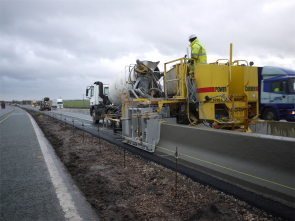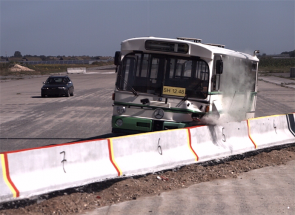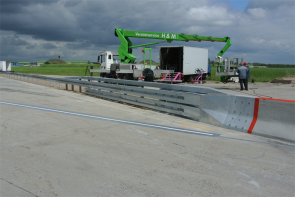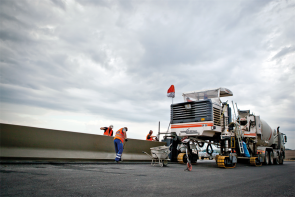Revising barrier regulations?
First published in The Global Road Safety Review 2015 as Barriers to progress
The passive safety market is complex, with regulations forming an important part of the picture – Thomas Edl explains
Passive safety systems are crucial for road infrastructure, but the regulations surrounding these in Europe are complex. Thomas Edl, managing director of Austrian-based DELTA BLOC International, a leading global supplier of precast and in-situ concrete vehicle restraint systems, explained some of the key issues.
Both the International Road Federation and the European Road Federation (IRF and ERF) are playing an important role in assisting the passive safety market as they hold regular workshops and other events. Edl said, “What the Road Federations do in their workshops is to train and provide information on the state of traffic safety to contractors and the local market. We also participated for example at the ERF’s recent event in Athens on best practice methods in different markets. These events are not a platform for specific stakeholders. They are a neutral platform and we want to share some of our global expertise.”
The issue of CE certification has been the centre of some discussion with regard to in-situ type barriers. Edl said, “There was an unclear situation in the market for several years now. Did the construction industry have to CE certify in-situ concrete barriers, yes or no?”
As a result of this uncertainty, the design of in-situ barriers has largely relied upon using earlier generation technology in the EU. But Edl said that the situation has changed within the EU and this now means that in-situ barriers do have to be CE certified, the European Commission is clear on that point.
There will be new crash testing carried out as a result and Edl said, “From our point of view it is a positive move in the market. It forces the industry to invest in new technology. If the European Commission had not clarified this, the technology would stay the same for the next decade. Now there is an incentive and that means only the safe and proven in-situ concrete barriers will be used on roads. It pushes the industry to develop new systems.”
One specific area where vehicle restraint regulations are changing within Europe are for transition sections. Crash testing for these transitions is now obligatory in Germany and France at present for example, and will be soon in other European countries also.
Edl explained that this is a highly important factor with significant safety benefits, “That connection between two significantly different types of barriers should always be tested and certified. It is a significant step forward for combining individual barrier types to a whole safe road design.”
He said that using the right barriers in the right application connected with the right transitions will deliver the correct whole safety solution. Edl commented, “To choose the right system for each application, you need to think outside the box compared to what the safety industry did in past years.
What we are promoting is the use of precast concrete, in-situ concrete and steel barriers always at their most suitable application to achieve a superior passive safety solution.” Given the array of systems on the market, supplying transition systems is not straightforward and Edl said, “We need a variety of solutions to connect all those barrier types together.”
However the complexity of the technology meant the firm sought partnerships and Edl said, “We did cooperate with different steel barrier suppliers.” He explained that firms operating in different market segments may have widely varying core competencies, which can be entirely complimentary when two firms from different segments work together. Using such an approach allows suppliers to join forces and offer a comprehensive package of solutions.
In the past one barrier type would be used in too many different applications but Edl said, “These days are over.” One size does not fit all he explained and added, “It sounds like a standard statement but this is what we see in many countries globally, this happens in practice. But there is still a long way to go for the Road Federations and the industry.”
Differing barrier types do pose issues for the industry and Edl said that knowledge sharing, such as that carried out by the IRF and ERF with their various events, is a priority. “There is a huge demand for training of road designers, authorities and contractors globally.”
The firm is keen to retain its position as an innovator and its own product development is carried out in Austria. However the company does work with partners for specific markets in France and Germany as well as designing special systems for the UK. One project for the UK has been to develop transition systems from the British open box beam and old type concrete barriers to their brand new in-situ concrete product range. The firm has also developed custom-made barrier solutions for countries including Latin America and Australia, while it has received national acceptance in Chile and Peru and is now installing its first products in those countries, and it also has strong interest from Brazil.
 In-situ type barriers are widely used in Europe and the US and in other territories for central reservations on major highways
In-situ type barriers are widely used in Europe and the US and in other territories for central reservations on major highwaysHe said that globally, authorities are keen to use the EN1317 standards because the requirements are to a high level. However the situation is more complex in some territories as the US standards are also very thorough and also widely accepted internationally. Edl said, “In Mexico we make our barriers to both standards. It’s tough for the industry to develop that variety of products for different regulations but it makes sense in some specific countries.”
Testing in Europe is very formalised but there are some concerns within Europe that testing standards vary. Edl is aware that not all of Europe’s barrier testing may be to the same quality standard and commented, “There might be quality differences in test reports and certification documents. I can only recommend national authorities to do detailed checking of test reports for recentness and accuracy. Good companies will always provide trustworthy and excellent test reports.”
Approval methodologies do vary within Europe and he said, “The Germans and British are very accurate and clear in their regulations. Other countries leave more freedom to their road designers.” Standards are becoming more sophisticated while there has been a shift towards the whole life costing approach to road construction and incorporating long-term maintenance, rather than initial construction costs.
In the UK the focus has been on maintenance-free barriers, both from cost and safety perspectives. Edl said, “They don’t want to see a road worker maintaining barriers in the central reserve which makes absolute sense,” explaining that ensuring personnel are out of the roadway while traffic is using the route will reduce the risk of work zone injuries or fatalities significantly.
Companies in this article
DELTA BLOC








